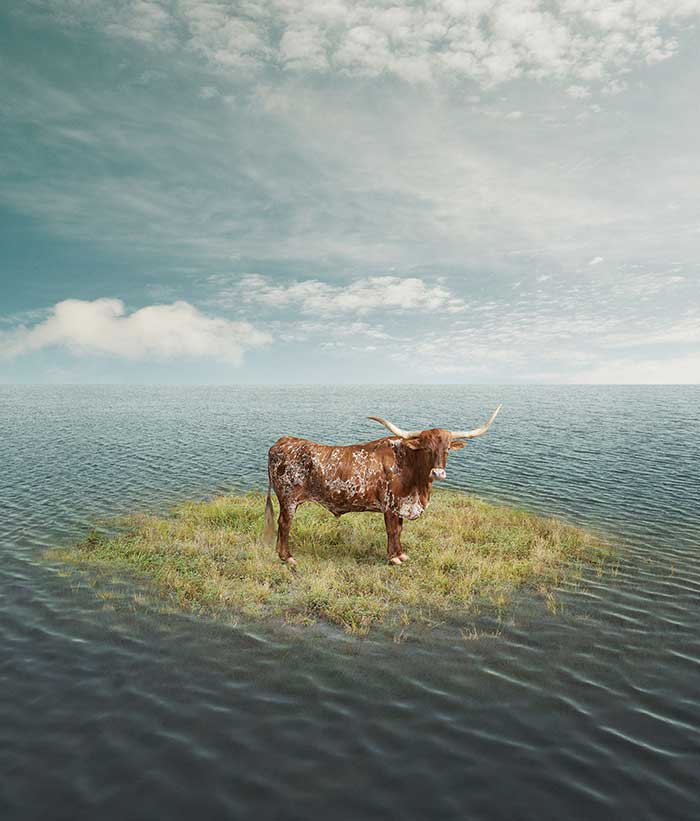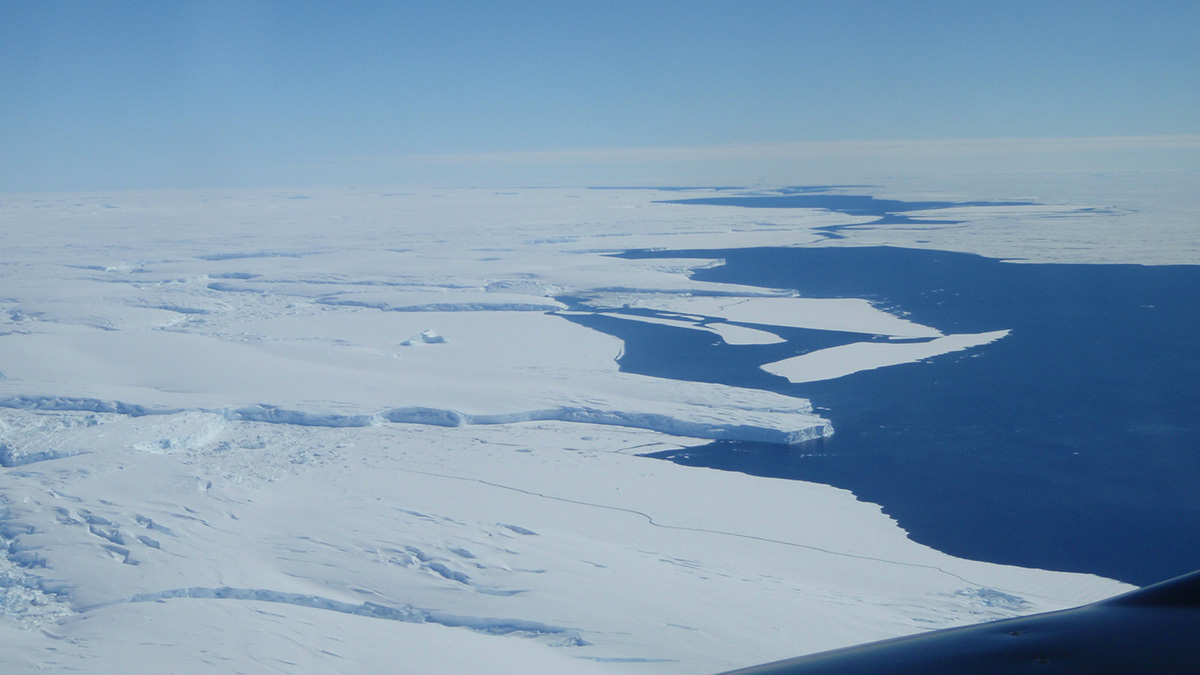Underwater
Climate change is happening now,
but some of its most extreme effects
are occurring half a world away.
How do we face a distant threat
before it arrives on Texas shores?
by JOE HANSON
I’m watching a child build a sand castle in Port Aransas. He’s picked a nice level plot on the beach. Sand consistency looks good, not too dry, not too wet. But it’s low tide, and I don’t have the heart to tell him that in a few hours that real estate is going to be underwater.
The wave destined to destroy his keep was born hundreds of miles offshore, beginning its life as windy ripples and tiny wavelets, joining with others, gaining momentum. Eventually it will push the ocean a few feet up onto the beach, wash away that sand castle, and then fall back again. It’s the way of things, as it’s always been.
But imagine a wave washing on shore, reaching up and up and up, and then never receding. Near the South Pole, an alarming series of events is unfolding that could make that a reality.
The ice sheets of Antarctica are some of the Earth’s most remote places, but they affect the lives of hundreds of millions residing near the world’s coastlines.

 Surfers and beach combers in Port Aransas. | © ZUMA Ralph Lauer/ZUMApress.com
Surfers and beach combers in Port Aransas. | © ZUMA Ralph Lauer/ZUMApress.com
In 2014 scientists announced that a massive ice sheet in West Antarctica is now trapped in an irreversible decline, a melt that could raise global sea levels by up to 13 feet. And earlier this year, researchers from the University of Texas Institute for Geophysics found that East Antarctica’s Totten Glacier, a shrinking mass of ice roughly the size of France, appears to be in similarly dire straits.
It’s hard to wrap your head around just how much water Antarctica holds. More than half of Earth’s freshwater is locked away there, enough to raise sea level by 200 feet if it all melted. Not all of Antarctica’s ice is at risk, of course, but Totten Glacier joins a growing number of runaway thaws that scientists fear it may be too late to avoid. Totten Glacier alone could swell global sea levels by as much as 11 feet, and that is on top of the already alarming numbers predicted for West Antarctica.
“We now know that this ice shelf has existed for at least 11,000 or 12,000 years, and soon it will be completely gone.”
Antarctica’s glaciers exist in a precarious balance. Melting is a normal process anywhere that ice meets ocean, but if a glacier is thawing out faster than inland snowfall can replenish it, the balance is disrupted. Almost all of a glacier’s melting occurs where the belly of the ice is exposed to the ocean. If warm ocean currents gain access to a glacier’s “grounding line,” the point where submerged ice rests on the Earth below, the rate of melting can increase, accelerating the glacier’s slide into the sea.
This is precisely what is happening beneath glaciers across Antarctica, according to Jamin Greenbaum, a researcher with the UT-Austin group. For the past eight years, Greenbaum has spent hundreds of hours in the air over Antarctica, peering through the ice to draw a more complete picture of Earth’s changing climate.
The Douglas DC-3 survey aircraft used by Greenbaum’s team, streaked with vermillion, with a low tail and wide wings, might look more at home in the final scene of Casablanca than humming over these frigid landscapes, but this particular plane is no stranger to the cold. Nearly 70 years ago it delivered U.S. paratroopers into the snowy forests of the Ardennes during the Battle of the Bulge.
That vintage airframe disguises a modern scientific research station. Inside, its parachute hooks have been replaced by racks of electronics. One instrument draws precise maps of surface elevation, while another scans for variations in Earth’s gravity. A cylindrical probe juts out from behind the tail, used to read tiny fluctuations in the planet’s magnetic field. Beneath the wings hang radar arrays tuned to penetrate deep into the layers of ice below.
When I joke about the skis affixed to the DC-3’s landing gear, Greenbaum is surprisingly matter-of-fact about unplanned snow landings hundreds of miles from their home base at Casey Station. At the bottom of the world, bad weather often arrives with little warning, and even though the team is chauffeured by experienced Canadian bush pilots, they don’t argue with Mother Nature. If you’re in the air when a storm rolls into base, you’re going to be camping on the ice that night.

 The survey airplane is refueled using 55-gallon drums following a flight. | Jack Holt
The survey airplane is refueled using 55-gallon drums following a flight. | Jack Holt
East and West Antarctica are disorienting labels in a place where every direction seems to be north. If you trace the Greenwich meridian through the South Pole, West Antarctica and its dragon’s tail of a peninsula lie roughly in the Western Hemisphere, while much larger East Antarctica spreads out beneath Asia and Australia.
Totten Glacier, due south of Perth, is where Greenbaum and his colleagues have focused their work for the past several years. It is named for George M. Totten, an officer aboard the U.S.S. Vincennes, which arrived in Antarctica in 1839 as part of the United States Exploring Expedition, the first American naval expedition to circumnavigate the globe. But Greenbaum doesn’t fancy himself a Totten, or an Amundsen, or a Scott for that matter. “We’re not exploring,” he says. “The reason we’re there is to understand why the ice is changing.”
For years, scientists knew that Totten Glacier was thinning, but weren’t sure why. From the air, Greenbaum mapped Earth’s terrain beneath the frozen mass and identified a deep cavity that he believes is allowing warm ocean water to seep under the ice and speed the glacier’s decline. Elsewhere in Antarctica, similar scenarios are leading to disastrous outcomes.
Ala Khazendar from NASA’s Jet Propulsion Laboratory has studied the Larsen B Ice Shelf in West Antarctica. In 2002, most of this floating ice sheet collapsed, sending a piece the size of Rhode Island drifting into the ocean and causing the glaciers behind it to speed up their descent to the sea. Khazendar is ringing a death knell for the ice that remains there. “We now know that this ice shelf has existed for at least 11,000 or 12,000 years,” he says, “and soon it will be completely gone.”
“These are problems that take decades and centuries to play out, and people don't need to jump in with solutions that may end up making it worse.”
Earth has seen this kind of thing before. About 120,000 years ago, prior to the most recent Ice Age and before humans had migrated out of Africa, Earth’s climate and geography were fairly similar to today, save for one key difference. During this Eemian period, oceans were anywhere from five to 30 feet higher than present levels. Where did this extra water come from? Ice cores drilled in Greenland suggest that it retained most of its ice during that time, so the only remaining culprit for Eemian sea level rise is melting glaciers in Antarctica, the same ones melting today.
Despite this precedent, what Khazendar has witnessed at Larsen B is enough to convince him that this time is different. “One thing that the past is telling us in this particular case is how unusual and how rapid these changes are taking place,” Khazendar says.
The word “collapse” makes it sound as though the melting and sea level rise are happening quickly and dramatically. But even the worst-case projections show the saga playing out over centuries.
“Frankly, this will happen at some point, if Antarctica continues to warm up,” says Ted Scambos, a scientist at the National Snow and Ice Data Center in Boulder, Colorado. “The question is, will it happen within a timeframe that is relevant to any current planning? Or so distant that there are no steps to take at this point?”
As concerned as scientists are about melting Antarctic glaciers, you’d be hard-pressed to see any such signs of alarm in Port Aransas. It’s life as usual along the Gulf Coast. Countless sunscreen-slathered families still flock to these beaches every year. Newly built vacation homes paint a pastel backdrop up and down the shore.
Melting glaciers are the reality in Antarctica, but apparently not in Texas.
The human brain is quite adept at turning a blind eye to threats. We’ll find ourselves explaining or rationalizing them away, and often we just refuse to think about them in the first place. How would children ever get to sleep at night if they didn’t develop the ability to ignore the various monsters under their beds? And the more distant the danger, the easier it is to disregard.
According to Harvard psychologist Daniel Gilbert, the risks presented by climate change often fail to resonate with people because they aren’t sufficiently P.A.I.N.-ful: personal, abrupt, immoral, and happening now. When faced with the distant and uncertain threat that is climate change, we tend to convince ourselves that we face much lower risks than we actually do, something Princeton psychology professor Daniel Kahneman calls our optimism bias. Car accidents only happen to other people. We’re less likely to be victims of crime than our neighbors are. Melting ice in Antarctica surely won’t affect us where we live.
But the effects of climate change are already washing up on Texas shores. According to Kiersten Stanzel, who studies coastal ecosystems for the Mission-Aransas National Estuarine Research Reserve, even without the threat of thawing Antarctic ice, rapid sea level rise is already causing erosion of Gulf of Mexico beaches and barrier islands, increased coastal flooding, and widespread habitat loss.
The critically endangered whooping crane is a towering bird whose population once dwindled to just 16 birds and now hovers around 600. These birds spend their winters wading through a handful of marshes and low-lying areas between Rockport and San Antonio Bay. Sea level rise threatens to wipe out half of the habitat that will be needed to bring this species off the endangered species list.
Add in the threats from East and West Antarctica, and the story gets even more troubling. Because of how melting Antarctic ice would redistribute the planet’s mass and gravity, North America and the Gulf Coast in particular are set to experience a greater share of sea level rise compared to elsewhere on the planet. Over the past 70 years, while average sea levels have risen about 2 millimeters per year worldwide, the tide station in Rockport has seen an increase of 5.5 millimeters per year.

 Long-term sea level rise could put parts of the Gulf Coast underwater. Totten Glacier could rise seas by 10-11 feet, and 197 feet represents the melting of all Antarctic ice. | Brown Bird Design/Map based on data from NOAA and NASA
Long-term sea level rise could put parts of the Gulf Coast underwater. Totten Glacier could rise seas by 10-11 feet, and 197 feet represents the melting of all Antarctic ice. | Brown Bird Design/Map based on data from NOAA and NASA
Residents of the Texas coast are no stranger to rising waters. Destructive storm surges swept in front of hurricanes and tropical storms are part of life here, but in the coming decades people may experience those water levels during every high tide. Industries from tourism to petroleum will be affected, although we don’t yet know how. Infrastructure from bridges to aquifers will be threatened by the encroaching ocean. Coastal ecosystems that support both economically important and environmentally threatened species will be irreversibly altered. But when?
Reports from the United Nations Intergovernmental Panel on Climate Change have always included a range of best- and worst-case sea level rise projections, but actual observations hover near the upper end of those estimates. This means scientists have tended to underestimate the actual pace of sea level rise. Even more troubling is that the U.N.’s past estimates have failed to take Antarctic melt into account, and the Gulf Coast may experience some of the higher-end sea level rise sooner than we think. This points to the need to begin planning now for how we are going adapt to rising water.

 Researchers Jamin Greenbaum and Dustin Schroeder fly aboard the ICECAP DC-3 airplane over Antarctica in November 2010. | Gregory Ng
Researchers Jamin Greenbaum and Dustin Schroeder fly aboard the ICECAP DC-3 airplane over Antarctica in November 2010. | Gregory Ng
In the aftermath of Hurricane Sandy, New York and New Jersey were awarded nearly $1 billion in federal funds to construct a storm- and flood-protection barrier around lower Manhattan and to build man-made breakwaters offshore. Governments along the Gulf Coast have yet to devote this level of response to the risk of rising seas, even in places like Louisiana, where the memory of Hurricane Katrina still remains vivid.
Some residents here are resistant to that sort of government intervention. Port Aransas resident Matt Richter works in the offshore oil industry, and as a fisherman and surfer, considers himself a steward of the Gulf Coast. But he’s not alarmed by Antarctic glaciers. “These are problems that take decades and centuries to play out,” Richter says, “and people don’t need to jump in with solutions that may end up making it worse.”
Still others doubt the severity of climate scientists’ predictions altogether. Gaylan Tucker, another local whom I found surfing with Richter, isn’t the least bit worried. “If we get 11 feet of water here, it’d be just fine with me. I live at 14.”
Tucker has lived and worked around Port Aransas for more than 16 years and hasn’t heard any evidence to convince him that climate change isn’t part of the natural cycles that accompany life on the Gulf Coast and elsewhere. “We can predict the surf better than they can predict the weather,” he says.
But weather is not climate, and an overwhelming majority of scientists are convinced that the Earth’s climate is being perturbed by human activity and that as a result, millions of people are at risk.
Shortly after Greenbaum’s research was published, his phone rang. On the other end was a couple in southwest Florida who had heard about his work on the news. With so much conflicting information, they didn’t know what to believe. Greenbaum looked at a map and noticed that the couple lived near the coast, about three feet above sea level. The husband and wife wanted to know if they should plan on giving their house to their children, or whether they should sell.
Greenbaum isn’t in the real estate business, but he took a few minutes with the couple to explain his research in simple terms. He pointed them to digestible summaries of scientific data instead of cable news. “What I told them was just to pay attention.”
Most scientists who study melting glaciers agree that issues like drought, water availability, extreme weather, and food security probably rank higher on the list of climate concerns, but with roughly a quarter billion people on Earth living within 16 feet of high tide, there is almost no issue related to the climate that can be untangled from the threat of melting ice and rising seas.
The threats posed by thawing ice and swollen oceans will not remain distant forever, though. But the question remains: How quickly will we turn our attention to them, and to all the climate issues they are tied to?
The threats are paralyzingly numerous and confusingly varied, but Ted Scambos believes that once we choose to face them, the solution is simple. “Address greenhouse gas emissions and the issues of sustainability of our economy and civilization,” he says. “Build a nation, and a planet, that will last as a home for us forever.”

Illustration by John Hendrix

 Surfers and beach combers in Port Aransas. | © ZUMA Ralph Lauer/ZUMApress.com
Surfers and beach combers in Port Aransas. | © ZUMA Ralph Lauer/ZUMApress.com














